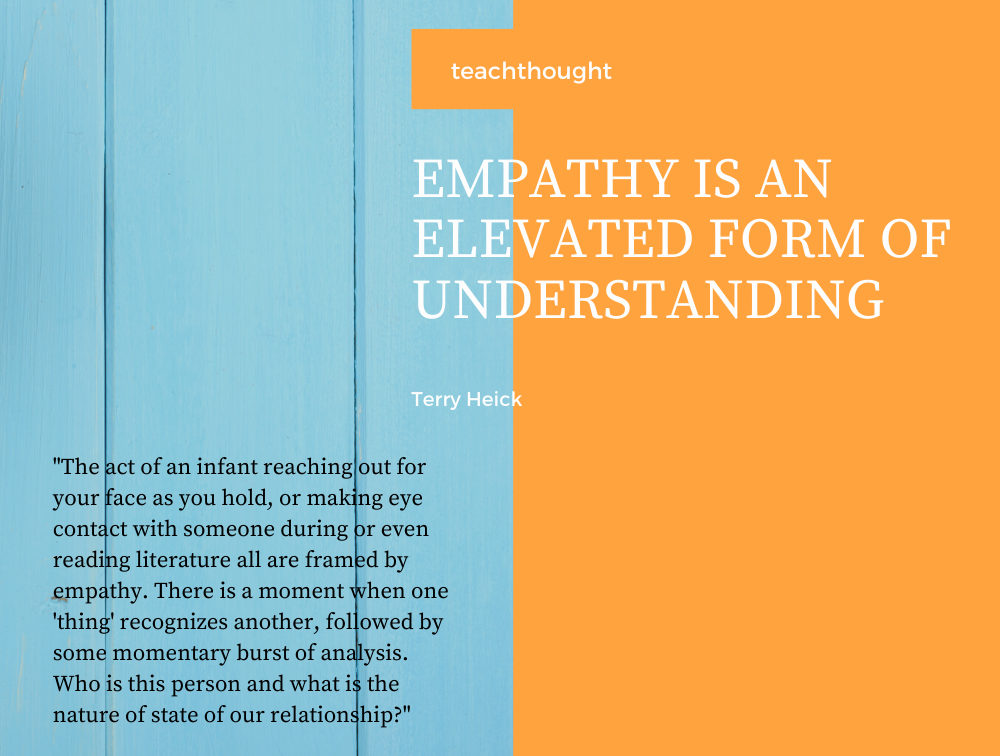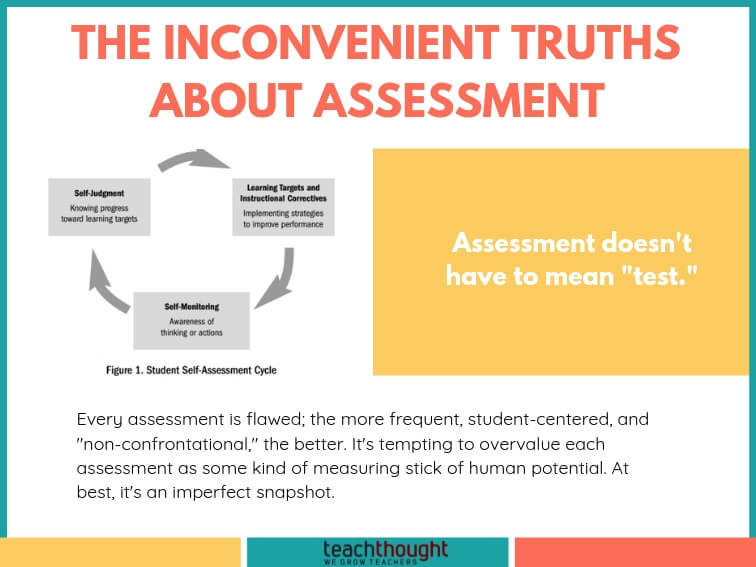
So much talk about empathy in education recently. Why? What’s the big idea?
The role of empathy in learning has to do with the flow of both information and creativity. A dialogic interaction with the world around us requires us to understand ourselves by understanding the needs and conditions of those around us. It also requires extended critical thinking and encourages us to take collective measurements rather than those singular, forcing us into an intellectual interdependence that catalyzes other subtle but powerful tools of learning.
See also Teaching Empathy In The Classroom: A Quick-Guide
If successful it should, by design, result in personal and social change through a combination of self-direction, reflection, and collaboration with ideas and the people who have them. This brings us to empathy.
The role of empathy in learning involves a dialogic interaction with the world around us. This emphasizes knowledge demands–what we need to know. It also encourages us to take collective measurements rather than those singular, forcing us into an intellectual interdependence that catalyzes other subtle but powerful tools of learning.
But where does it come from? What causes it? What are the authentic sources of empathy in a classroom?
See Also 30 Of The Best Books To Teach Children Empathy
Empathy Source: Analysis of ‘Other’
Whether by close academic examination, more personal ‘evaluation,’ or some kind of analysis that’s in-between, ‘other’ lays the groundwork for empathy.
The act of an infant reaching out for your face as you hold, or making eye contact with someone during a conference, or even reading literature all are framed by empathy–or suffer tremendously without it. There is a moment when one ‘thing’ recognizes another, followed by some momentary burst of analysis. Who is this person? Are they a threat, an opportunity, or neither? What do I need from them, and them from me? What social contracts or etiquette are at work here that I need to be aware of and honor?
Literary study is probably the most iconic case for empathy in a traditional learning environment. A novel requires the reader to see the world through one (or more) of the character’s eyes–to understand their motives and draw close to their worldview so that can have a fictional-but-still-parallel experience.
Empathy Source: Your interactions with them
This is a powerful opportunity to model empathy. Reinforcement of desired behaviors. Socratic discussion. Grading writing. Evaluating projects. Missing homework. Behavior problems. All of the dozens of interactions you have with students on a daily basis are opportunities for them to see what empathy looks like.
This doesn’t mean they necessarily will, in turn, use it with others, but there’s no chance at all for that to happen if they don’t even know what they’re looking for. Your empathy with them may be the only empathy they’ve ever seen.
Empathy Source: Their interactions with one another
Another opportunity to see empathy in action is in working with one another—quick elbow-partner activities, group projects, peer response, group discussions, and more. Sharing sentence stems that promote empathetic dialogue can be helpful to students—like training wheels so they know where to start.
“I can tell you’ve…that must have…” as in, “I can tell you’ve worked hard on this writing. That must’ve taken self-determination, and even some courage.”
Empathy Source: How Content Is Framed
How content is framed is another opportunity for empathy. For example, using essential questions that require, reward, and promote empathy can turn a unit into a study on what other people think, why they think it, and what they feel?
Grant Wiggins often referred to “What’s wrong with Holden Caufield?” from The Catcher In The Rye as a powerful essential question, one that requires students to examine another person in an alien context, make deep inferences based on a schema that is (obviously) personal, and then—hopefully—empathize with a fictional character, not as a quick writing prompt or ‘higher-level question,’ but a 6-week study.
Studying fiction—or studying fiction well is an exercise in empathy as well. Studying history without empathy is like turning our shared human legacy, full of wonderful nuance and narrative and scandal and hope—into a dry, chronologically-based FAQ. Which sucks.
Empathy Source: Where Learning Goals Come From
The relationship between learning goals and empathy may not be clear, but what we choose to study and why we choose to study it are—ideally—primarily human pursuits. When these are handled outside of the classroom, e.g., in the form of curriculum standards, scopes-and-sequences, maps, units, power standards, and the lessons that promote their study, this places the institution immediately at odds with the student and sterilizes the learning experience.
When students are able to look to other schools, other classrooms, their own lives, or even non-academic ‘fields’ to see how experts and passionate creatives identify, value, and improve their own knowledge and skills, it can help to tilt the learning experience to something emotionally immediate and relevant and authentic—fertile ground for empathy.
Empathy Source: Transfer Of Knowledge
What do we do with what we know? What happens when I try to take what I learned here, and use it there? What are my thinking habits? What are the chances I’ll make this transfer unprompted, now and in the future?
These questions surrounding students’ transfer of knowledge can all benefit from empathy, and promote its growth. Understanding is a problematic word, but let’s consider for a moment two kinds of understanding—that which is demonstrated within the context of a lesson or unit, and that which is able to leave this fragile academic bubble and can survive on its own outside of it. (Or better yet, be useful in that outside world.) This kind of movement isn’t simple, or necessarily natural when they are learning content and goals are all academic.
In The Courage To Think Critically,I was theorized as much:
“To think critically about something is to claim to first circle its meaning entirely—to walk all the way around it so that you understand it in a way that’s uniquely you. That’s not academic vomit but fully human. After circling the meaning of whatever you’re thinking critically about—navigation necessarily done with bravado and purpose—you then analyze the thing.
See its parts, its form, its function, and its context. After this kind of survey and analysis, you can come to evaluate it–bring to bear your own distinctive cognition on the thing so that you can point out flaws, underscore bias, emphasize merit—to get inside the mind of the author, designer, creator, or clockmaker and critique his work.”
Empathy Source: Movement Within & Across Learning Taxonomies
Another example? Understanding by Design’s ‘6 Facets of Understanding.’ Note the progression:
6 Facets of Understanding–Peaking With Empathy & Self-Knowledge
“Facet 1: Explain
Provide thorough and justifiable accounts of phenomena, facts, and data.
Facet 2: Interpret
Examples: Tell meaningful stories, offer apt translations, provide a revealing historical or personal dimension to ideas and events; make subjects personal or accessible through images, anecdotes, analogies, and models.
Facet 2: Apply
Examples: Effectively use and adapt what they know in diverse contexts.
Facet 4: Have perspective
Examples: See and hear points of view through critical eyes and ears; see the big picture.
Facet 5: Empathize
Examples: Find value in what others might find odd, alien, or implausible; perceive sensitively on the basis of prior indirect experience.
Facet 6: Have self-knowledge
Examples: Perceive the personal style, prejudices, projections, and habits of mind that both shape and impede our own understanding; they are aware of what they do not understand and why understanding is so hard.”
The movement in the 6 Facets here is from outward patterns to inward patterns. Explaining, interpretation, and application are, in large part, outward. The facets then tend inward—perspective, empathize, and self-knowledge. The lesson here–or one lesson of many–is that understanding is a deeply personal process. It is a matter of knowledge, but also identity, perspective, and empathy.
Why Is Teaching Empathy Important?
The role of empathy in learning is significant because it helps students to understand and connect with the material they are learning. Empathy allows students to step into someone else’s shoes and see the world from their perspective. This can be helpful in subjects like history, where it is beneficial for students to understand the motivations behind historical events. Additionally, empathy can help students to connect with people from different cultures and backgrounds, which can be valuable in a global society.
In order to learn effectively, students must be able to understand and feel what it is like to be in another person’s shoes. This is where empathy comes in. Empathy allows students to see the world from another person’s perspective and develop compassion for others. It is a vital component of social-emotional learning and can help students build relationships, communicate better, and resolve conflicts.
Conclusion
Our TeachThought Learning Taxonomy includes domains of ‘Self,’ ‘Interdependence,’ ‘Function,’ and ‘Abstraction,’ implying the human, emotional, and connected nature of learning. Learning is about experimenting through, playing with, and otherwise coming to internalize new information and perspective. Knowledge-holding is only one part of ‘knowing.’
Empathy provides not only provides a common ground between people–and a human tone–but also an authentic need to know what we know and use that knowledge to improve the interactions we value the most.



